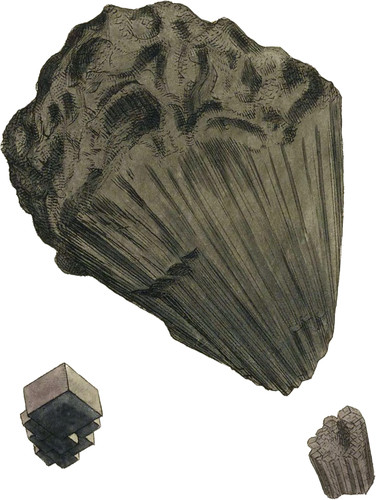 Enlarge
Enlarge
British Mineralogy
Madreporite? or Radiated Carbonate of Lime
- Div. 2. Imitative.
- Syn.
- Madrepor-stein. Journal des Mines, n. 47. p. 831.
- Madreporite. Haüy, 4. 378.
When I gathered this specimen, which seemed to have fallen from the rock at Bow-and-Arrow Castle, on the Isle of Portland, I was instigated to keep it as of an uncommon construction, to serve as a memorandum of the place, and to recall to my memory the nature of that part of my excursion. This sort of relic, though sometimes not very handsome, is nevertheless pleasing; and it is a continual enjoyment of a pleasure to be reminded of it.
This has been rendered of more consequence, since it is a curious example of the utility of the knowledge of crystallization, which in this case distinguishes it from a coral; and might have made the substance called Madreporite better understood. It is said, “the Madreporite belonging to the class of calcareous stones, found by M. de Mollé some years ago at Russbachthall, in the county of Salzbourg, is a stone of transportation. Some specimens weigh from twenty to thirty pounds.”
“Externally it resembles Basaltes, so much, that some Mineralogists considered it to be the same; others believed that it was produced from Madrepores; but it discovers no certain characters of a primitive organic formation: besides, it has so great a resemblance to the real Madrepores, that it has thence borrowed its name. It is of a gray colour, composed of divergent prisms, brilliant on their transverse fracture, and of a black and duller colour on the longitudinal fracture. The fracture exhibits a tissue of small bent laminae; it is entirely opaque, brittle, rough to the touch, and of moderate hardness; the intervals between the bundles which compose it are in part filled with small white leaves of Calcareous Spar.”
There are three or four analyses of this substance. According to Mollé, a hundred grains of it contain,
| Lime | 634/10 |
| Alumine | 302/10 |
| Iron | 1010/15 |
Analysed by Klaproth, it was found to contain,
| Carbonate of Lime | 93 00 |
| ————— Magnesia | 0 50 |
| ————— Iron | 1 25 |
| Charcoal | 0 50 |
| Sandy Silex | 4 50 |
| An atom of Oxide of Manganese | |
| 99 75 |
Haüy’s experience gave him reason to think himself satisfied that this substance, which has been made so conspicuous, is a Carbonate of Lime; and my specimen is a confirmation of this opinion, being certainly nearly the same thing ; but now the improved knowledge in crystallography helps us more readily to decide it. Like the Madreporite, at first sight it looks like Basalt, and somewhat resembles a Coral, or Madrepore, and shines on the transverse fracture; viz. on the faces of the primitive rhomb which discover it: indeed, we know of nothing in the description that does not sufficiently accord with ours. The small bent laminæ are a consequence of the radiation—see tab. 131. This is an example of one of the dullest specimens of Carbonate of Lime of the crystallized and divergent kind, dulled with adventitious matter: thence the variations of the analysis.

